Loading AI tools
Guimarães, the first capital city of Portugal, is filled with a multitude of notable and historic buildings that fill its historic centre, a World Heritage Site due to its size and preservation,[1] and other surrounding areas. This article serves as a comprehensive list of the many notable buildings in the city, divided into different categories, and organized following the alphabetical order system.
List of the numerous historical landmarks in Guimarães, from various distinct time periods, that had a big impact on the history of the city and of Portugal.
| Name | Location | Description | Image | Construction | Coordinates |
|---|---|---|---|---|---|
| Alfândega Tower | Oliveira, São Paio e São Sebastião | Last standing defensive tower of the medieval fortifications of Guimarães, used as a publicity billboard between the early 1900s and 1934 (date of its restoration).[2] It holds the iconic Aqui Nasceu Portugal (Here Portugal Was Born) sign, reminding everyone that Portugal's independence was achieved in the premises of the city, that was added in the 1960s.[2] On 3 August 2024 a museum was inaugurated inside the Alfândega Tower.[3] |  |
1200s[4] | 41.44136°N 8.29501°W |
| Castle of Guimarães | Oliveira, São Paio e São Sebastião | It was built under the orders of Mumadona Dias in the 10th century to defend the city from attacks by Moors and Norsemen.[5] |  |
900s[5] | 41.44793°N 8.29043°W |
| Castro houses | Briteiros São Salvador e Briteiros Santa Leocádia and Sande São Lourenço e Balazar | Typical houses of the Pre-Roman inhabitants of northern Portugal, called Castros. Guimarães has two conglomerates of Castro houses, called Citânias: the Citânia de Briteiros[6] and the Citânia de Sabroso.[7] |  |
200 BC/100 BC | 41.52787°N 8.31568°W and 41.51191°N 8.34149°W |
| Paços do Concelho de Guimarães | Oliveira, São Paio e São Sebastião | It served as the old City Hall of Guimarães and later as an art gallery.[8] |  |
Before 1612[8] | 41.44316°N 8.29301°W |
| Padrão do Salado | Oliveira, São Paio e São Sebastião | Monument commissioned by Afonso IV of Portugal in commemoration for the victory at the Battle of Río Salado.[9] | 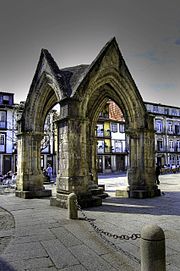 |
1340[9] | 41.44284°N 8.29279°W |
| Palace of the Dukes of Braganza (Paço dos Duques) | Oliveira, São Paio e São Sebastião | Old palace of the Dukes of Braganza, now used as a museum and the official residence of the President in northern Portugal.[10] |  |
1420[10] | 41.446485°N 8.290807°W |
List of notable buildings initially intended for residential use, mostly casas (houses) of rich and noble families.
| Name | Location | Description | Image | Construction | Coordinates |
|---|---|---|---|---|---|
| Affordable Housing District | Oliveira, São Paio e São Sebastião | Small complex made up of four four-storey buildings. On the opposite side of the street stands the Martins Sarmento High School. |  |
1970[11] | 41.44492°N 8.28870°W |
| Botequim do Vagomestre | Toural; Oliveira, São Paio e São Sebastião | The Botequim do Vagomestre was both a Botequim and a Social club that opened probably in 1816 and was closed in 1894.[12] Liberalist ideas were often discussed here as these were highly unpopular at that time and the Botequim had regular periods without clients due to fear.[12] It is currently a residencial building and a Teahouse. |  |
1700s | 41.44183°N 8.29600°W |
| Café Milenário Building | Oliveira, São Paio e São Sebastião | 19th century buildings at the entrance of the Toural, next to the Alfândega Tower, that houses the Café Milenário, the most famous café of the city and birthplace of Vitória S.C..[13] |  |
1800s[14] | 41.44144°N 8.29519°W |
| Casa Correia de Matos | Oliveira, São Paio e São Sebastião | House designed by José Marques da Silva for the Correia de Matos family.[15] |  |
1902[16] | 41.43990°N 8.29543°W |
| Casa da Caldeiroa | Oliveira, São Paio e São Sebastião | House in the Caldeiroa Street that is being used as refuge to migrant children from war-torn countries, it was inaugurated in 2023.[17] |  |
Previous building adapted in 2022 | 41.43990°N 8.29616°W |
| Casa da Família Ribeiro da Silva | Oliveira, São Paio e São Sebastião | Noble house built in the late 1600s or early 1700s located at the Misericórdia Square. |  |
1600s/1700s[18] | 41.44264°N 8.29499°W |
| Casa da Rua Nova | Oliveira, São Paio e São Sebastião | Extremely well preserved example of Portuguese medieval architecture. |  |
1300s[19] | 41.44158°N 8.29336°W |
| Casa das Hortas | Oliveira, São Paio e São Sebastião | Manor house in Guimarães with a coat of arms.[20] |  |
Late 1700s[20] | 41.44252°N 8.28854°W |
| Casa das Rótulas | Oliveira, São Paio e São Sebastião | Prime example of noble-ish medieval architecture in Portugal. |  |
1600s[21] | 41.44388°N 8.29431°W |
| Casa de Caneiros | Fermentões | Manor house built on top of the ruins of the previous Casa de Caneiros from the 1500s.[22] |  |
1770[22] | 41.45503°N 8.30984°W |
| Casa de Cimães | Oliveira, São Paio e São Sebastião | Baroque house of the Pinto Coelho family, partially destroyed due to a fire in 2016.[23] |  |
1700s[24] | 41.44039°N 8.29787°W |
| Casa de Donães | Oliveira, São Paio e São Sebastião | Peculiar corner house covered in Azulejos, restored in 2016.[25] |  |
1800s[25] | 41.44216°N 8.29276°W |
| Casa de Margaride | Mesão Frio | Noble rural 16th century house, that traces its roots to the 11th century,[26] where Portugal's Tree of the Year of 2024, the Camélia, is located.[27] |  |
1500s[26] | 41.44517°N 8.29274°W |
| Casa de Sezim | Nespereira | Noble house known internationally for its Vinho Verde production.[28] |  |
1300s[29] | 41.41498°N 8.32822°W |
| Casa do Alto | Nespereira | In the 20th century, Raul Brandão reconstructed and restored the house and lived here for long periods of time.[30] | 1560[30] | 41.401607°N 8.325197°W | |
| Casa do Barão de Pombeiro | Oliveira, São Paio e São Sebastião | 19th century house in the revivalist Tudor style, replacing the typical wooden frames with the more abundant granite. It was originally owned by a Baron and it later became a kindergarten in 1974.[31] Its located in the extermity of the Santa Maria Street. [31] |  |
Between 1850-1899[31] | 41.44517°N 8.29274°W |
| Casa do Bravo | Urgezes | 19th century manor house. It suffered a big fire in 1875.[32] |  |
1800s[33] | 41.42708°N 8.28723°W |
| Casa do Carmo | Oliveira, São Paio e São Sebastião | The Casa do Carmo or Casa dos Conde Margaride, is a noble house that often received the Portuguese kings at the city of Guimarães.[34] |  |
Late 1700s or early 1800s[35] | 41.44637°N 8.29268°W |
| Casa do Carvalhal | Guardizela | Manueline 18th century tower house.[36] | 1700s | 41.38993°N 8.36692°W | |
| Casa do Castro | Oliveira, São Paio e São Sebastião | The Casa do Castro[37] is a traditional house located at the D. João IV Avenue. It is currently used as a restaurant.[38] |  |
1700s/1800s[39] | 41.43802°N 8.29135°W |
| Casa do Costeado | Creixomil | Noble house. It suffered a massive fire in 6 April 1948.[40] In 2024 it went through restoration and rehabilitation works, to be turned into a school/hotel.[41] |  |
Late 1700s[42] | 41.43793°N 8.30357°W |
| Casa do Fidalgo do Toural | Toural; Oliveira, São Paio e São Sebastião | Manor house at the Toural Square that serves as a bank since 1878.[43] |  |
1721[43] | 41.44200°N 8.29616°W |
| Casa do Largo de Santa Luzia | Oliveira, São Paio e São Sebastião | Noble house where Francisco Agra lived. |  |
1800s[44] | 41.44542°N 8.29568°W |
| Casa do Leite | Oliveira, São Paio e São Sebastião | Noble house located at the Santa Maria Street, besides the Raul Brandão Municipal Library. |  |
Late 1800s[45] | 41.44442°N 8.29292°W |
| Casa do Morgado da Índia | Oliveira, São Paio e São Sebastião | Noble house prized for its preservation status,[46] located in the small section of the Santa Maria Street that passes through the Santiago Square. |  |
1500s[46] | 41.44373°N 8.29265°W |
| Casa do Morgado dos Almeidas | Oliveira, São Paio e São Sebastião | Extremely well preserved 17th century noble house. |  |
Before 1681[47] | 41.44276°N 8.29378°W |
| Casa do Proposto | Oliveira, São Paio e São Sebastião | Noble house and former industrial school where Bernardo Pinheiro Correia de Melo was born.[48] |  |
1710[48] | 41.44373°N 8.29912°W |
| Casa dos Araújo e Abreu | Oliveira, São Paio e São Sebastião | Noble house, used as a B&B since the early 2000s.[49] |  |
1600s[49] | 41.44359°N 8.29458°W |
| Casa dos Braganças de Cete | Oliveira, São Paio e São Sebastião | The Casa dos Braganças de Cete[50] is a Rococo noble house located at the Santa Maria Street. |  |
1700s | 41.44499°N 8.29270°W |
| Casa dos Carneiros (Raul Brandão Municipal Library) | Oliveira, São Paio e São Sebastião | Noble house, currently used as the municipal library of Guimarães. |  |
1834[51] | 41.44422°N 8.29291°W |
| Casa dos Carvalhos | Oliveira, São Paio e São Sebastião | Manor house of the majorat of the Carvalhos in the Santa Maria Street.[52] |  |
1500s[52] | 41.44457°N 8.29286°W |
| Casa dos Condes de Vila Pouca | Oliveira, São Paio e São Sebastião | Noble house, currently used as a religious institute and a kindergarten. |  |
1700s[53] | 41.44060°N 8.28820°W |
| Casa dos Coutos (Tribunal da relação of Guimarães) | Oliveira, São Paio e São Sebastião | Noble house, currently used as one of the 5 tribunais da relação of Portugal. |  |
1600s[54] | 41.44263°N 8.29453°W |
| Casa dos Freitas do Amaral | Toural; Oliveira, São Paio e São Sebastião | Also known as Casa do Guardal, paying homage to the former residence of the Freitas do Amaral family in Guimarães, which was destroyed during the Portuguese Civil War,[55] it stands today as the sole surviving house in the Toural adorned with a coat of arms. |  |
Late 1700s[56] | 41.44091°N 8.29533°W |
| Casa dos Laranjais | Oliveira, São Paio e São Sebastião | Noble medieval house, known for its tower and orange groves (Laranjais in portuguese) that give the house its name. |  |
1300s[57] | 41.44473°N 8.29381°W |
| Casa dos Lobatos | Urgezes | Noble house in the Caldeiroa Street where the Banda dos Guises was founded.[58] |  |
1773[58] | 41.43964°N 8.29634°W |
| Casa dos Lobos Machados | Oliveira, São Paio e São Sebastião | Rococo style noble house where the Commercial and Industrial Association of Guimarães was founded in 1865. 15th century walls, 13th century ceramic and coins from the reign of Afonso V and Sebastian I where found here during excavations in the 2000s.[59] |  |
1754[59] | 41.44235°N 8.29448°W |
| Casa dos Moreira do Vale | Oliveira, São Paio e São Sebastião | 18th century noble house, currently used as a funeral parlor. |  |
1700s[60] | 41.44202°N 8.29677°W |
| Casa dos Navarro de Andrade (Alfredo Pimenta Municipal Archive) | Oliveira, São Paio e São Sebastião | Noble house used as the municipal archive of Guimarães since 1952.[61] |  |
1600s[61] | 41.44398°N 8.29356°W |
| Casa dos Peixotos | Oliveira, São Paio e São Sebastião | First of the many noble houses at the Santa Maria Street after leaving the Oliveira Square. |  |
1700s[62] | 41.44338°N 8.29260°W |
| Casa dos Ribeiro de Carvalho | Oliveira, São Paio e São Sebastião | Noble baroque house of Branco Ribeiro de Carvalho, a knight of the Military Order of Christ.[63] It’s now used as a labor court. | 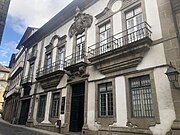 |
1761[63] | 41.44210°N 8.29658°W |
| Casa dos Santoalha | Oliveira, São Paio e São Sebastião | The Casa dos Santoalha, Casa do Canto or Quinta do Campo, is a noble house and a popular stop during the Moinas of the Nicolinas. | 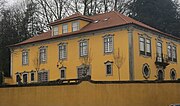 |
1700s[64] | 41.43862°N 8.29067°W |
| Casa dos Valadares de Carvalho | Oliveira, São Paio e São Sebastião | Last of the many noble houses at the Santa Maria Street going up from the Oliveira Square. |  |
1400s[65] | 41.44518°N 8.29249°W |
| Casa dos Valadares de Vasconcelos | Oliveira, São Paio e São Sebastião | 17th century noble house near the Santiago Square. |  |
1600s[66] | 41.44349°N 8.29369°W |
| Casa Dr. António Rocha | Oliveira, São Paio e São Sebastião | House by the architects Luís José Oliveira Martins and Delfim Amorim.[67] |  |
1947[67] | 41.44538°N 8.29380°W |
| Casa Martins Sarmento | Oliveira, São Paio e São Sebastião | Neoclassic house built by Francisco Martins Sarmento in the mid-1800s.[68] |  |
Between 1833 and 1884[68] | 41.44562°N 8.29332°W |
| Casa Mota-Prego | Oliveira, São Paio e São Sebastião | Now mostly used as a restaurant,[69] it received the Public Interest Building status in 2018 via the decree n.º 980/2018, DR, 2.ª série, n.º 202/2018[70] and the Municipal Interest Building status in 2019 via the decree n.º 352/2019, DR, 2.ª série, n.º 52/2019.[71] |  |
1500s[72] | 41.44331°N 8.29444°W |
| Casa no Largo do Cidade | Oliveira, São Paio e São Sebastião | House with a oratory built in 1866.[73] It’s being used as an inn since 2004.[73] | 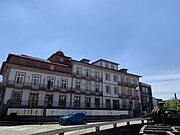 |
1800s[73] | 41.43987°N 8.29302°W |
| Cineclub of Guimarães | Oliveira, São Paio e São Sebastião | Residential building at the João Franco Square that was converted into a cineclub in 1958.[74] |  |
1700s/1800s | 41.44292°N 8.29493°W |
| Da Vinci Building (Unofficial name) | Toural; Oliveira, São Paio e São Sebastião | The building was built sometime after the fire that destroyed the north part of the Toural in 1869.[75] It follows the Pombaline style. |  |
Sometime after 1869[76] | 41.44239°N 8.29589°W |
| Palace of São Cipriano | Tabuadelo e São Faustino | Noble baroque palace that follows the tower house (later expanded) model.[77] |  |
1415[77] | 41.39699°N 8.28820°W |
| Pousada de Nossa Senhora da Oliveira | Oliveira, São Paio e São Sebastião | 17th century building at the Oliveira Square that serves as an inn since 1979.[78] | 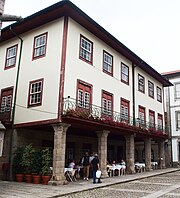 |
1600s[78] | 41.44319°N 8.29278°W |
| Quinta do Sacoto | Guardizela | Quinta with roots dating back to the 12th century.[79] | Before 1800s | 41.38749°N 8.35452°W | |
| Torre dos Mirandas | Oliveira, São Paio e São Sebastião | Former tower house with a manueline window. |  |
1500s/1600s | 41.44216°N 8.29396°W |
| Urgezes House | Urgezes | House of wealthy origins in Urgezes. |  |
1886[80] | 41.42251°N 8.29817°W |
List with notable buildings whose function is based on providing services, such as Hotels, Banks, Theatres, Factories…
| Name | Location | Description | Image | Construction | Coordinates |
|---|---|---|---|---|---|
| Arquinho Factory | Urgezes | Historic factory and future house of the Aerospace Research Centre of the University of Minho.[81] |  |
1913[82] | 41.43850°N 8.29749°W |
| Assembly of Guimarães | Costa | The Assembly of Guimarães is an association founded in 1962 whose statutory aims are to provide its members with cultural and recreational activities and promote the moral and material progress of the municipality.[83] The institution’s headquarters were designed by Fernando Távora[84] and it was built between 1969 and 1972, following the modernist style.[85] |  |
1969[85] | 41.44666°N 8.28441°W |
| Associação Familiar Vimaranense Building | Oliveira, São Paio e São Sebastião | Headquarters of the Associação Familiar Vimaranense, an association that provides various services such as medical consultations and funerals.[86] |  |
1933[87] | 41.44510°N 8.29179°W |
| Avenida Factory | Urgezes | The Fábrica da Avenida was part of the Companhia de Fiação e Tecidos de Guimarães, that also owned another factory in Campelos and a hydroelectric plant in Ronfe.[88] |  |
1897[89] | 41.43597°N 8.29219°W |
| Bercel Clothing Factory | Urgezes | Historic old clothing factory. Part of the roof collapsed on 17 March 2024.[90] | 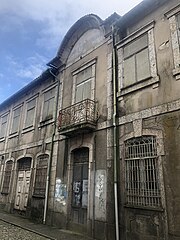 |
Late 1800s or early 1900s | 41.43926°N 8.29867°W |
| Castanheiro Factory | Urgezes | Historic factory, now used partly as an apartment complex.[91] | 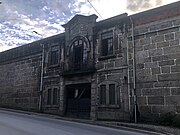 |
1883[92] | 41.43472°N 8.30062°W |
| Correios de Guimarães | Oliveira, São Paio e São Sebastião | Old post office building, built on top of its predecessor, inaugurated on 21 November 1980, it remained in operation until 2016.[93] |  |
1980[94] | 41.44419°N 8.29445°W |
| Courthouse of Creixomil | Creixomil |  |
41.43757°N 8.31597°W | ||
| Courthouse of Guimarães | Oliveira, São Paio e São Sebastião | The Courthouse of Guimarães was built between May 1955 and 1960, being inaugurated by president Américo Tomás on 24 June of that year.[95] |  |
1955[95] | 41.44453°N 8.29065°W |
| Garagem Avenida | Urgezes | Situated adjacent to the Jordão Theatre, the Garagem Avenida predates the theatre's construction and stood as the primary car repair shop in Guimarães throughout the 20th century. | 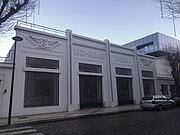 |
Before 1937[96] | 41.43916°N 8.29514°W |
| Hotel da Penha | Costa | Hotel located at the summit of the Penha Mount, next to the sanctuary of the same name, inaugurated in 1894 and remodeled in 1971.[97] |  |
1894[97] | 41.43258°N 8.26934°W |
| Hotel Fundador | Urgezes | Hotel and tallest building in Guimarães. |  |
1971[98] | 41.4361°N 8.2961°W |
| Hotel Guimarães | Urgezes | Hotel next to the Fundador Hotel, in Urgezes. |  |
41.43614°N 8.29702°W | |
| Hotel Ibis Guimarães | Creixomil |  |
|||
| Hotel Mestre de Avis | Oliveira, São Paio e São Sebastião | ||||
| Hotel Santa Luzia | Azurém | ||||
| Hotel Toural | Oliveira, São Paio e São Sebastião | ||||
| Jordão Theatre | Urgezes | Art Deco theatre built in 1938, by Júlio de Brito, due to the lack of proper entertainment structures in the city.[96] |  |
1938[99] | 41.43888°N 8.29518°W |
| Madroa Factory | Urgezes | Historic textile factory | Early-mid 1900s | 41.43937°N 8.29883°W | |
| Moinho do Buraco Factory | Selho | Historic textile factory | 1890[100] | 41.42223°N 8.35253°W | |
| Railway station (old) | Urgezes | Train station that served the city of Guimarães between 1884 and 2004.[101] | 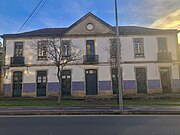 |
1884[101] | 41.43547°N 8.29532°W |
| Railway station (new) | Urgezes | New train station that serves Guimarães since 2004.[102] |  |
2004[102] | 41.43527°N 8.29402°W |
| Santa Casa da Misericórdia of Guimarães | Oliveira, São Paio e São Sebastião | Former hospital and current Santa Casa da Misericórdia of Guimarães. |  |
1606[103] | 41.44238°N 8.29494°W |
Sports in Guimarães are largely influenced by Vitória S.C., with Moreirense F.C. also holding a significant position. Below is a compilation of notable sports-related venues and locations in Guimarães.
| Name | Location | Functionality | Image | Coordinates |
|---|---|---|---|---|
| Estádio D. Afonso Henriques | Oliveira, São Paio e São Sebastião | Stadium of Vitória S.C., the main football club of the city, was built in 1965 and renovated in 2003 for Euro 2004.[104] It regularly hosts international matches. |  |
41.44586°N 8.30095°W |
| Guimarães Sports Centre | Spread across the Municipality | Comprises many facilities distributed throughout Guimarāes, providing spaces for sports practice and hosting large-scale events. |  |
Multiple |
| Multiusos de Guimarães | Creixomil | Multi-purpose arena, used for hosting fairs, exhibitions, congresses, concerts and sporting events. |  |
41.43449°N 8.30514°W |
| Parque Joaquim de Almeida Freitas | Moreira de Cónegos | Stadium of Moreirense Football Club. |  |
41.37807°N 8.35458°W |
| Name | Location | Description | Image | Year inaugurated |
|---|---|---|---|---|
| Árvore da Paz (Peace Tree) | Azurém | Sculpture by Aureliano Aguiar, in the Padre Luís Gonzaga Fonseca Square, near the Afonso Henriques Stadium. |  |
2003?[105] |
| Guimarães de Duas Caras (Guimarães of the two faces) | Oliveira, São Paio e São Sebastião | Statue depicting a soldier with two faces. The two faces depict the two lines of defense following the Portuguese conquest of Ceuta. |  |
1877?[106] |
| Monumento ao Nicolino | Oliveira, São Paio e São Sebastião | Monument made to honor those who participate at the Nicolinas. |  |
2008[107] |
| O Devorador de Automóveis (The Devourer of Cars) | Azurém | Sculpture of a monster eating a car, at the Campus of Azurém, designed by José de Guimarães. |  |
1981 or 1991[108] |
| Padrão de D. João I | Creixomil | Monument commissioned by King John I (later replaced in the 1500s by the current structure) to honor of the Portuguese conquest of Ceuta or the Portuguese victory at the Battle of Aljubarrota.[109] |  |
Around 1517[109] |
| Rapariguinha (Little Girl) | Oliveira, São Paio e São Sebastião | Statue by António de Azevedo near the Toural Square. |  |
1934?[110] |
| Statue of Afonso Henriques by João Cutileiro | Oliveira, São Paio e São Sebastião | Statue depicting king Afonso I of Portugal, designed by João Cutileiro, at the João Franco Square. |  |
2001[111] |
| Statue of Afonso Henriques by Soares dos Reis | Oliveira, São Paio e São Sebastião | Statue depicting king Afonso I of Portugal, designed by João Cutileiro, located besides the Paço dos Duques. | 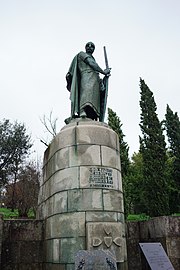 |
1887[112] |
| Statue of Mumadona Dias | Oliveira, São Paio e São Sebastião | Statue of Mumadona Dias, in front of the Courthouse of Guimarães. |  |
1960[113] |
| Statue of Pius IX | Costa | Statue depicting pope Pius IX, at the Penha Sanctuary. |  |
1893[114] |
| World Heritage Monument | Oliveira, São Paio e São Sebastião | Monument of the World Heritage emblem, celebrating the status given to the Historic Centre of Guimarães in 2001, located at the Campo da Feira. | 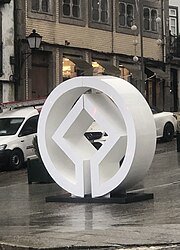 |
2020[115] |
Wikiwand in your browser!
Seamless Wikipedia browsing. On steroids.
Every time you click a link to Wikipedia, Wiktionary or Wikiquote in your browser's search results, it will show the modern Wikiwand interface.
Wikiwand extension is a five stars, simple, with minimum permission required to keep your browsing private, safe and transparent.